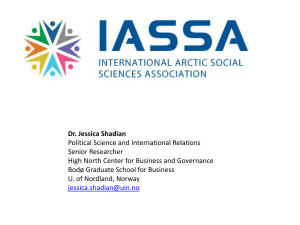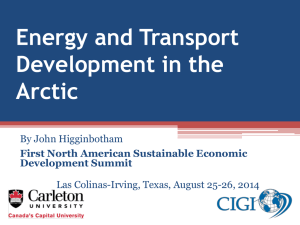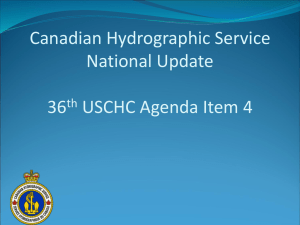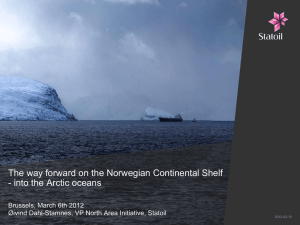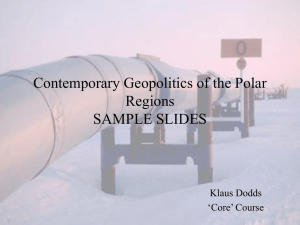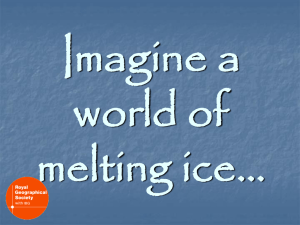EU Energy Policy
advertisement
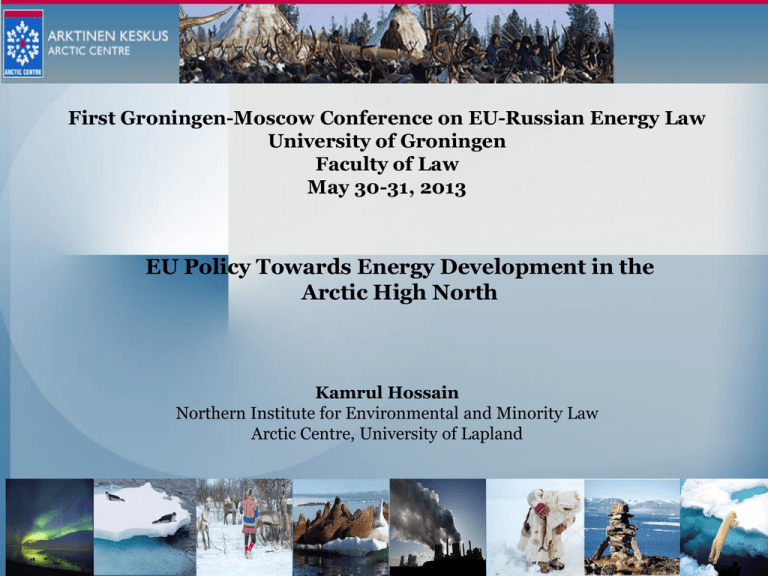
First Groningen-Moscow Conference on EU-Russian Energy Law University of Groningen Faculty of Law May 30-31, 2013 EU Policy Towards Energy Development in the Arctic High North Kamrul Hossain Northern Institute for Environmental and Minority Law Arctic Centre, University of Lapland Contents Why the EU is interested in the Arctic High North? EU Policy towards High North Arctic Energy Resources and Environmental Challenges EU Energy Policy Governance Conclusion Why the EU is interested in the Arctic High North? Interests International Trade (shipping and transportation) Fishing Energy Other Economic activities Stewardship Climate change and Environment Arctic Inhabitants/ Indigenous Peoples EU Arctic Policy Development October 2008: November 2008: December 2009: January 2011: June 2012: EU Parliament resolution on Arctic Governance EU Commission Communication on the European Union and the Arctic region European Council conclusions on Arctic issues Parliament Resolution sustainable EU Policy in the High North. Joint Communication - Developing a European Union Policy towards the Arctic Region: progress since 2008 and next steps EU Policy goal for the Arctic Protecting arctic environment in unison with its population Promoting sustainable exploitation of Arctic resources and Improving Arctic multilateral governance Action Knowledge Responsibility Engagement Stewardship: Climate Change and Environment Between 2003 and 2008 melting of Arctic glaciers, ice caps and the Greenlandic ice sheet contributed to 40% global sea level rise. EU has incorporated 20% of greenhouse gas reduction commitment into law. Emission reduction commitment of 80-95% by 2050 Promotion of high standard in international climate regulations. Investment in Arctic research on environmental and climate change agenda Stewardship: Arctic Inhabitants/ Indigenous Peoples Involvement of Arctic population Indigenous peoples and protection of their rights Sustainable use of natural resources Arctic Hydrocarbon Resources Arctic Fields and Other Locations Source: Oilfield Review Winter 2010/2011, Vol. 22, No. 4, p. 39; Copyright © 2011, Schlumberger The map shows the most promising areas for finding undiscovered, or yet-tofind (YTF), conventional hydrocarbon resources. The height of each column represents the volume of YTF resources (red for gas and green for oil) in billions of barrels of oil equivalent. The base of each column is plotted approximately at the basin location. Source: Oilfield Review Winter 2010/2011, Vol. 22, No. 4, p. 41; Copyright © 2011, Schlumberger These graphs present the Arctic YTF resource volume, type and location compared with the rest of the world. The data indicate that most of these resources consist of natural gas in Russia. Source: Oilfield Review Winter 2010/2011, Vol. 22, No. 4, p. 41; Copyright © 2011, Schlumberger EU Energy Imports: With enlarged EU in 2007 energy dependence increased by: 84 % imported natural gas 93 % imported oil Current figures: 50 % of the total EU energy consumption is imported 38 % of oil imports come from Russia 15 % of oil imports come from Norway 53 % from the European High North 65–70 % rise is predicted in next 20 years Arctic Energy Development will have Adverse Environmental Consequences: Acceleration of Climate Change Pollution by oil spills Difficulties in clean-up operation Adverse impact on marine living resources Other indirect impacts Impact on the livelihood of indigenous peoples EU Energy Policy No integrated energy policy A set of policies connecting Energy market Energy efficiency Climate change Lisbon Treaty opened the way for a true EU Energy Policy EU Energy Policy: Sustainability Climate change Competition/Efficiency Supply security Governance Legitimacy Promotion of multilateral cooperation UN LOS Convention Arctic Council Initiatives EU High North Cooperation Circumpolar Cooperation: Arctic Council Regional Cooperation: Barents Euro-Arctic Council Northern Dimension Policy Regulatory Challenges: Fragmented regulations with implication of offshore development LOS Convention 1982 OPRC Convention 1991 London Convention 1972 MARPOL 73/78 Convention Regional and bi-lateral agreements Arctic Council Oil Spill Agreement Espoo Convention OSPAR Convention Agreement on Five European Arctic Nations Bilateral Agreements Lack of centralized regulations Soft-law initiatives Conclusion Can environmental sustainability be met with existing EU Policy towards the Arctic? What future for Arctic energy – is moratorium an option? If not, what then? Thank you for your attention!

